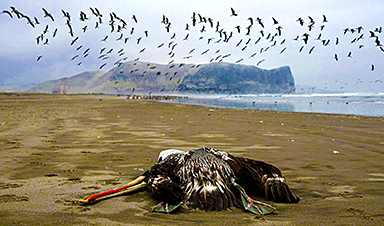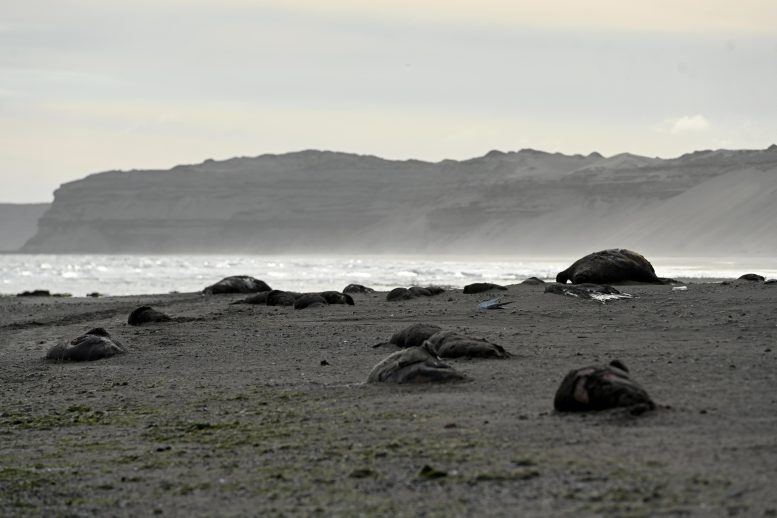A study from the University of California, Davis, and the National Institute of Agricultural Technology (INTA) in Argentina reveals that the highly contagious H5N1 avian influenza virus has evolved to transmit among birds and marine mammals, presenting a direct risk to wildlife conservation efforts.
The study, published in the journal Emerging Infectious Diseases, is the first genomic characterization of H5N1 in marine wildlife on the Atlantic shore of South America.
For the study, scientists collected brain samples from four sea lions, one fur seal, and a tern found dead at the most affected sea lion rookery in Argentina. All tested positive for H5N1.
Genome sequencing revealed that the virus was nearly identical in each of the samples. The samples shared the same mammal adaptation mutations that were previously detected in a few sea lions in Peru and Chile, and in a human case in Chile. Of note, the scientists found all these mutations also in the tern, the first such finding.
Elephant seals lie dead on a beach in Argentina following an outbreak of avian influenza in the region in 2023. Credit: Maxi Jonas
“This confirms that while the virus may have adapted to marine mammals, it still has the ability to infect birds,” said first author Agustina Rimondi, a virologist from INTA. “It is a multi-species outbreak.”
We know this because the virus sequence in the tern retained all mammal-adaptation mutations. Such mutations suggest a potential for transmission between marine mammals.
“This virus is still a relatively low risk for humans,” said senior author Marcela Uhart, a wildlife veterinarian with the UC Davis School of Veterinary Medicine’s One Health Institute and director of its Latin America Program within the Karen C. Drayer Wildlife Health Institute. “As long as the virus continues to replicate in mammals, it may make it a higher concern for humans. That’s why it’s so important to conduct surveillance and provide early warning.”
The journey of H5N1
Uhart calls clade 2.3.4.4b — the current variant of H5N1 – “this new monster.” It emerged in 2020, while the human world was reeling from a different pandemic, COVID-19. Avian influenza began killing tens of thousands of sea birds in Europe before moving to South Africa. In 2022, it entered the U.S. and Canada, threatening poultry and wild birds. It migrated to Peru and Chile in late 2022.
Then, almost exactly a year ago, in February 2023, highly pathogenic avian influenza entered Argentina for the first time. But it was not until August 2023 — when the virus was first found in sea lions at the tip of South America on the Atlantic coastline of Tierra del Fuego — that the virus unleashed its fatal potential in the region. From there, it moved swiftly northward, with deadly results, first for marine mammals and later for seabirds.
A recent paper Uhart co-authored showed a large outbreak killed 70% of elephant seal pups born in the 2023 breeding season. Mortality rates reached at least 96% by early November 2023 in the surveyed areas of Península Valdés in Argentina.
“When it first came to Argentina, we didn’t know if it would affect elephant seals,” Uhart said. “We never imagined the magnitude of what was to come.”
Since 2022, H5N1 in South America has killed at least 600,000 wild birds and 50,000 mammals, including elephant seals and sea lions in Argentina, Chile, and Peru, and thousands of albatrosses in the Malvinas/Falkland Islands.
Moving south
The virus is now heading southward from South America, and scientists are deeply concerned about its potential impact on penguins and other wildlife in Antarctica.
Uhart and Ralph Vanstreels, her colleagues at UC Davis’ Latin America Program in the School of Veterinary Medicine, are conducting wildlife surveillance for H5N1 in Antarctica this month.
“We need to keep an eye on the ability of this virus to reach species that have never been exposed to an H5N1 infection before,” Rimondi said. “The consequences in those species can be very severe.”
The concept of One Health honors the interconnectivity among humans, domestic animals, wildlife, and the environment. Interspecies disease outbreaks are unsettling examples of such connections and require global collaboration among public, wildlife, agricultural, health, and other sectors.
“We are trying to be at the forefront of documenting, recording, and providing early warning,” Uhart said. “We’ve been in this area for 30 years. We know these species. We work with scientists who have 30 years of data on these populations, so we can know what will be important for the future. We have to give voice to these poor creatures. Nobody’s taking note of how big this is.”
Reference: “Highly Pathogenic Avian Influenza A(H5N1) Viruses from Multispecies Outbreak, Argentina, August 2023” by Agustina Rimondi, Ralph E.T. Vanstreels, Valeria Olivera, Agustina Donini, Martina Miqueo Lauriente and Marcela M. Uhart, April 2024, Emerging Infectious Diseases.
DOI: 10.3201/eid3004.231725
News
Team finds flawed data in recent study relevant to coronavirus antiviral development
The COVID pandemic illustrated how urgently we need antiviral medications capable of treating coronavirus infections. To aid this effort, researchers quickly homed in on part of SARS-CoV-2's molecular structure known as the NiRAN domain—an [...]
Drug-Coated Neural Implants Reduce Immune Rejection
Summary: A new study shows that coating neural prosthetic implants with the anti-inflammatory drug dexamethasone helps reduce the body’s immune response and scar tissue formation. This strategy enhances the long-term performance and stability of electrodes [...]
Scientists discover cancer-fighting bacteria that ‘soak up’ forever chemicals in the body
A family of healthy bacteria may help 'soak up' toxic forever chemicals in the body, warding off their cancerous effects. Forever chemicals, also known as PFAS (per- and polyfluoroalkyl substances), are toxic chemicals that [...]
Johns Hopkins Researchers Uncover a New Way To Kill Cancer Cells
A new study reveals that blocking ribosomal RNA production rewires cancer cell behavior and could help treat genetically unstable tumors. Researchers at the Johns Hopkins Kimmel Cancer Center and the Department of Radiation Oncology and Molecular [...]
AI matches doctors in mapping lung tumors for radiation therapy
In radiation therapy, precision can save lives. Oncologists must carefully map the size and location of a tumor before delivering high-dose radiation to destroy cancer cells while sparing healthy tissue. But this process, called [...]
Scientists Finally “See” Key Protein That Controls Inflammation
Researchers used advanced microscopy to uncover important protein structures. For the first time, two important protein structures in the human body are being visualized, thanks in part to cutting-edge technology at the University of [...]
AI tool detects 9 types of dementia from a single brain scan
Mayo Clinic researchers have developed a new artificial intelligence (AI) tool that helps clinicians identify brain activity patterns linked to nine types of dementia, including Alzheimer's disease, using a single, widely available scan—a transformative [...]
Is plastic packaging putting more than just food on your plate?
New research reveals that common food packaging and utensils can shed microscopic plastics into our food, prompting urgent calls for stricter testing and updated regulations to protect public health. Beyond microplastics: The analysis intentionally [...]
Aging Spreads Through the Bloodstream
Summary: New research reveals that aging isn’t just a local cellular process—it can spread throughout the body via the bloodstream. A redox-sensitive protein called ReHMGB1, secreted by senescent cells, was found to trigger aging features [...]
AI and nanomedicine find rare biomarkers for prostrate cancer and atherosclerosis
Imagine a stadium packed with 75,000 fans, all wearing green and white jerseys—except one person in a solid green shirt. Finding that person would be tough. That's how hard it is for scientists to [...]
Are Pesticides Breeding the Next Pandemic? Experts Warn of Fungal Superbugs
Fungicides used in agriculture have been linked to an increase in resistance to antifungal drugs in both humans and animals. Fungal infections are on the rise, and two UC Davis infectious disease experts, Dr. George Thompson [...]
Scientists Crack the 500-Million-Year-Old Code That Controls Your Immune System
A collaborative team from Penn Medicine and Penn Engineering has uncovered the mathematical principles behind a 500-million-year-old protein network that determines whether foreign materials are recognized as friend or foe. How does your body [...]
Team discovers how tiny parts of cells stay organized, new insights for blocking cancer growth
A team of international researchers led by scientists at City of Hope provides the most thorough account yet of an elusive target for cancer treatment. Published in Science Advances, the study suggests a complex signaling [...]
Nanomaterials in Ophthalmology: A Review
Eye diseases are becoming more common. In 2020, over 250 million people had mild vision problems, and 295 million experienced moderate to severe ocular conditions. In response, researchers are turning to nanotechnology and nanomaterials—tools that are transforming [...]
Natural Plant Extract Removes up to 90% of Microplastics From Water
Researchers found that natural polymers derived from okra and fenugreek are highly effective at removing microplastics from water. The same sticky substances that make okra slimy and give fenugreek its gel-like texture could help [...]
Instant coffee may damage your eyes, genetic study finds
A new genetic study shows that just one extra cup of instant coffee a day could significantly increase your risk of developing dry AMD, shedding fresh light on how our daily beverage choices may [...]






















